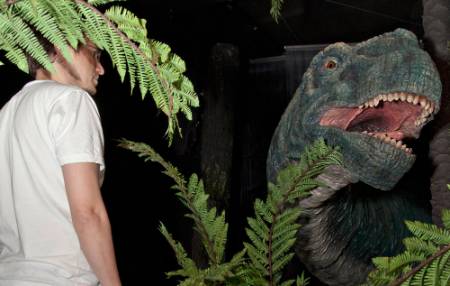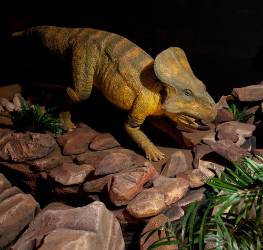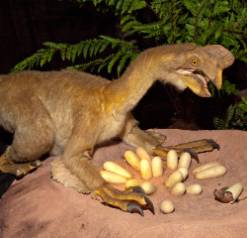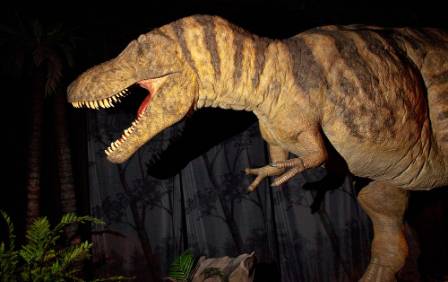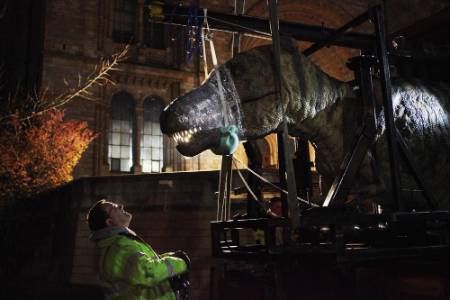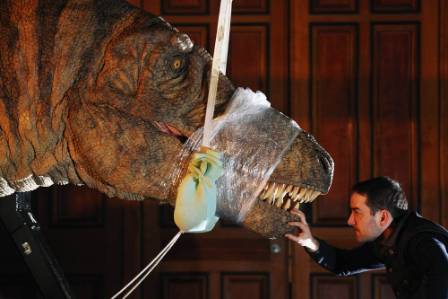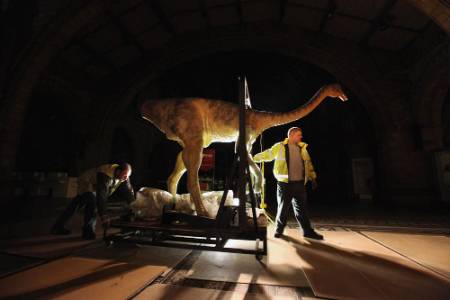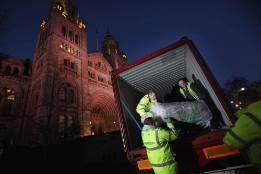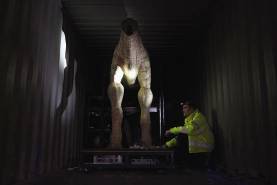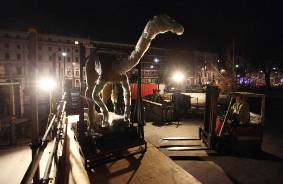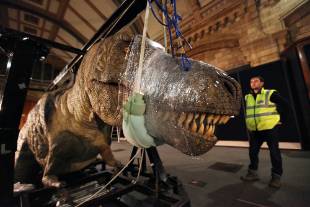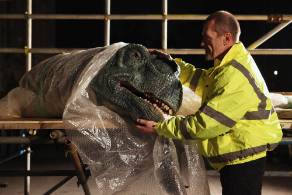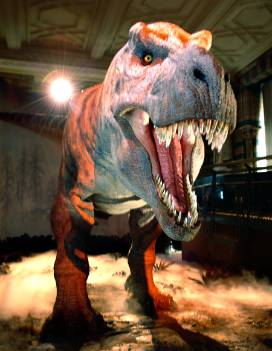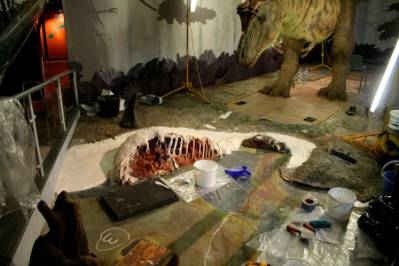In two days from now, our Age of Dinosaur exhibition opens to the public on Good Friday, 22 April. Just in time for Easter weekend.
'I'm not hungry' moans Camarasaurus, the first animatronic dinosaur you'll meet in the Age of Dinosaurs exhibition
I peeped into the gallery yesterday to see how the exhibition was coming along. Paul Gallagher, the exhibition's installation manager, is relieved installation is nearing its conclusion. 'Now, the only things left to do are to install the smells and misting machines and complete the final snagging, lighting levels in the two Immersive environments and the showcases. We also need to do some paint touch-ups and set dressing.'
As I enter the Jurassic zone, Paul and his team, are busy trying to give Camarasaurus a big bunch of ferns to eat.
The enormous lurching head and neck of Camarasaurus is the first encounter that visitors will have with the animatronic dinosaurs in the exhibition. The guys make several attempts to coax the beast, without success. Understandably though, as Camarasaurus is one of the biggest giant plant-munching sauropods and getting close to that mouth looked pretty daunting. From its perch on a rock opposite, Archaeopteryx looks on inquisitively.
Screech and sqwak: Protoceratops, left, and Oviraptor, right - two of the noisiest animatronic stars of the exhibition's Cretaceous zone. Select all images to enlarge them
Moving on to the Cretaceous zone, I'm startled by the noises of the five animatronic dinosaurs in this desert habitat. The sounds are pretty alarming, particularly the screech of Protoceratops and the Oviraptor's cry. Maybe Protoceratops is afraid that the prowling, feathery Velociraptor, not far away, will steal its eggs...
Of course, the roar of Tarbosaurus, above - the final animatronic dinosaur and T.rex's terrible twin - is awesome. I'm transfixed to the ground, which trembles from the power of that roar, by the gaping teeth and fearsome jaws as the creature lunges towards me. But drawn to it strangely, and imagine myself riding on top of the giant predator for some reason! I think it's because you get so close to the dinosaurs in this exhibition, it makes them all the more real.
It intrigues me how we know about the different dinosaur noises, so I ask Paul and he says: ''The dino roars actually come pre-set with the creatures from Kokoro the manufacturer, in Japan. We can’t alter them. But we did develop the Archaeopteryx noise.'
Georgina, the exhibition's interpretation manager, tells me the noises are actually educated guesswork really. 'Scientists look at similar types and sizes of animal live today,' she says. 'They compare what these sound like and their hearing ranges and piece it together through that.'
Paul Barrett, the Museum's renowned dinosaur researcher confirms this: 'Georgina is spot on. We can deduce hearing ranges in dinosaurs though measuring the size of the part of the inner ear that houses the organ of hearing (the size of this is related to the hearing range). And through looking at body size. Comparisons with closely-related animals, and animals with similar behaviours, flesh this out. For example, we know that the hearing range of Archaeopteryx was very similar to that of an emu, crow or magpie, so we selected crow and magpie calls for the animatronic.'
Undeniably, it's the six animatronic dinosaurs and one animatronic dino-bird that are the stars of the show.
But there's lots more to discover in this exhibition including rare plant and marine specimens, a huge variety of dinosaur body parts, large-scale graphic timelines, illustrations and scientific research panels. Along with interactive challenges and a CGI film.
Have a look at the new Age of Dinosaur exhibition slideshow to see what awaits you
There will be more news of the exhibition and a video trailer coming soon, so watch this space.



